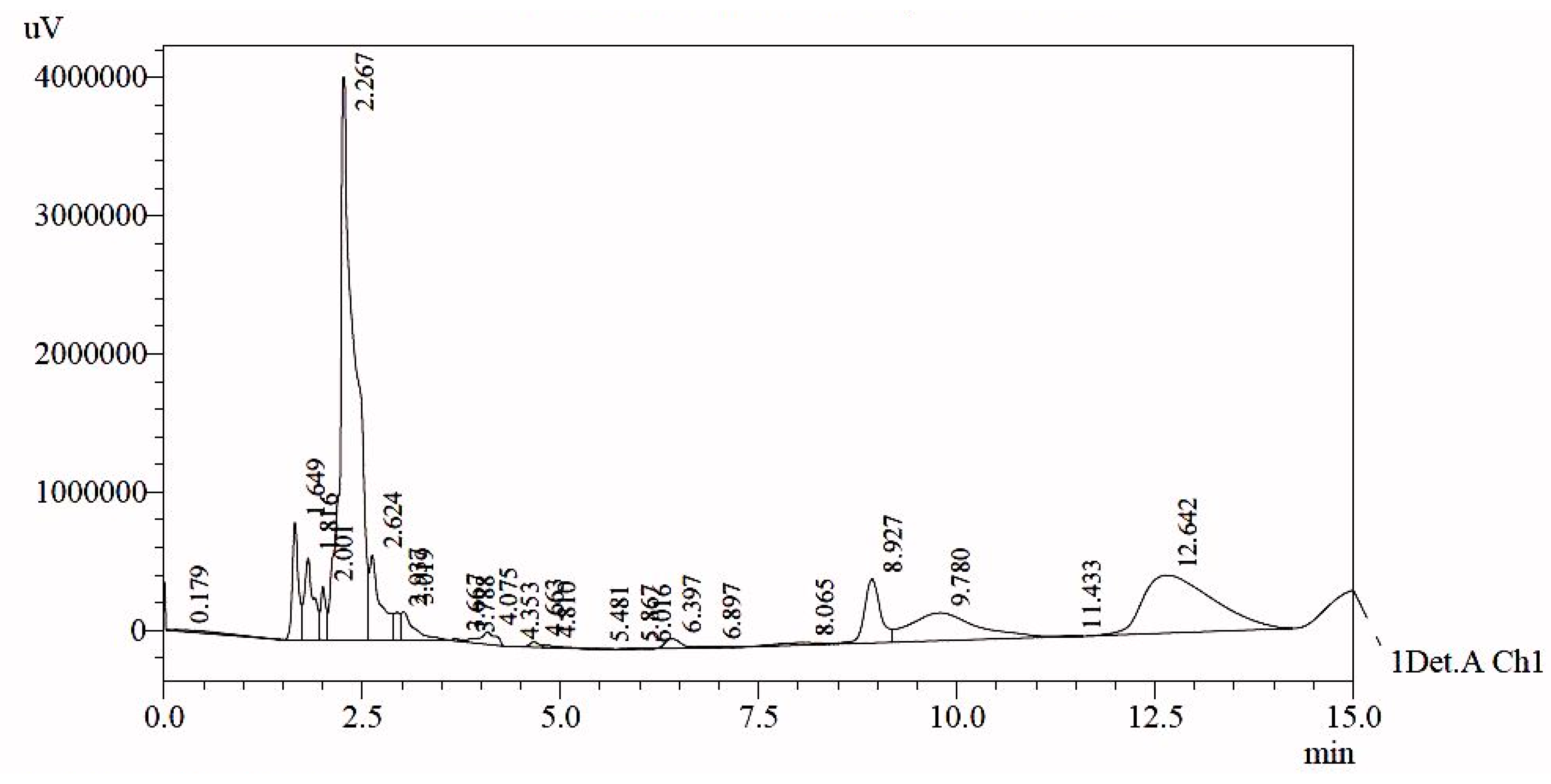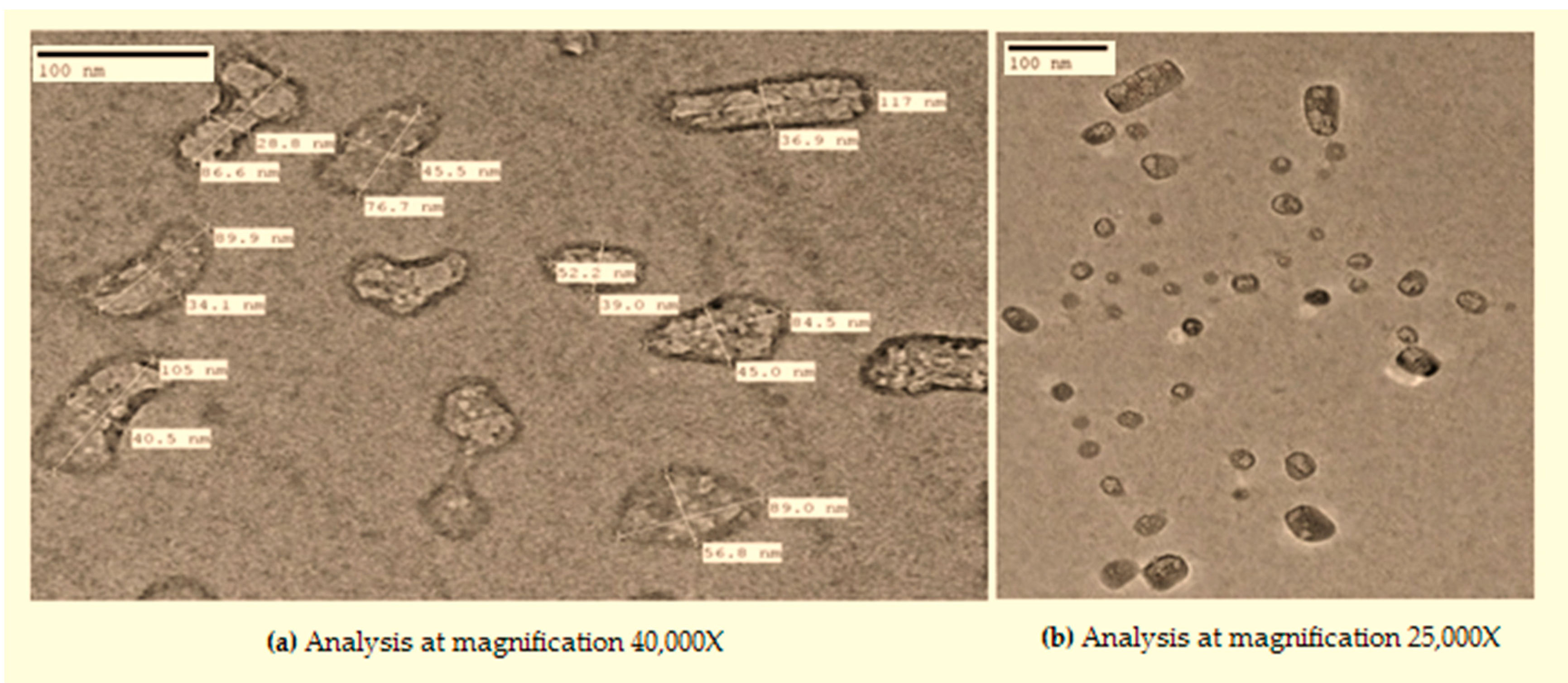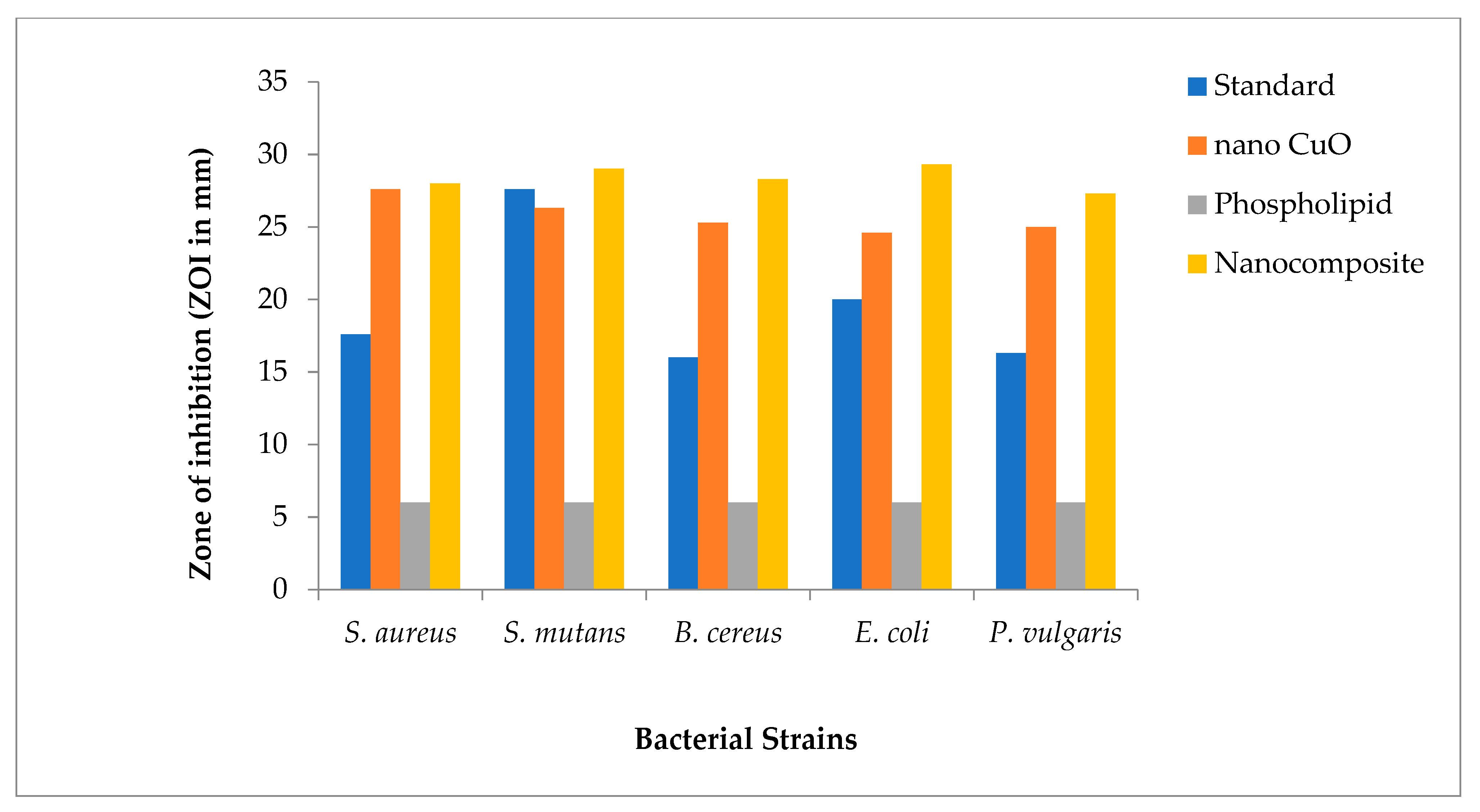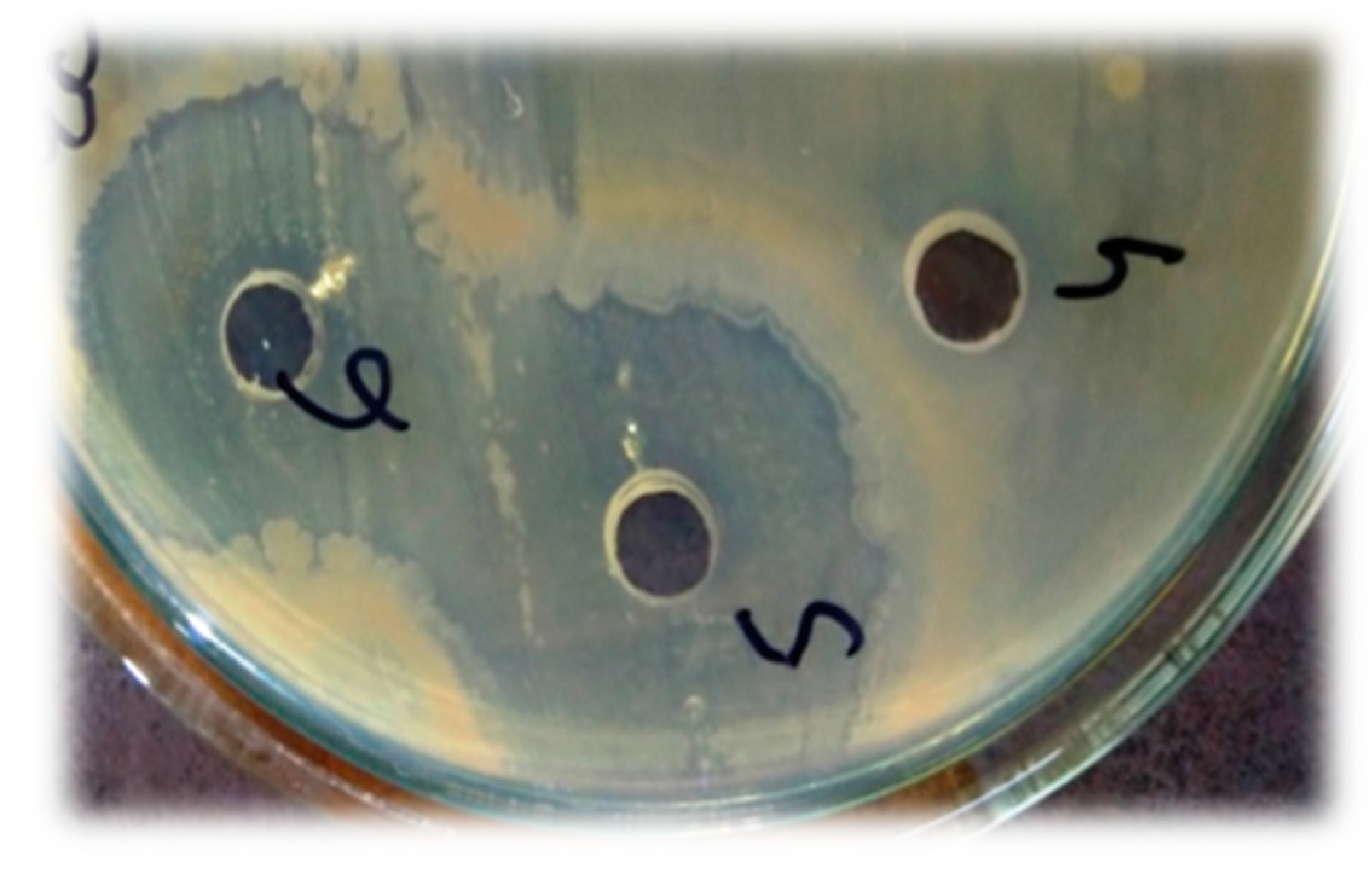CuO Bionanocomposite with Enhanced Stability and Antibacterial Activity against Extended-Spectrum Beta-Lactamase Strains
Abstract
:1. Introduction
2. Materials and Methods
2.1. Crude Phospholipids Isolation and Analysis
2.1.1. Isolation of Crude Phospholipids from Egg Yolk
2.1.2. HPLC Analysis
- The HPLC System: Shimadzu Prominence Isocratic HPLC System (Kyoto, Japan), was used for the study. The system consists of an LC-20AD solvent supply unit, Rheodyne Injector, porous silica with 5 µm diameter C18250 × 4.6 mm column, and a UV visible SPD-20A detector system.
- Selection of Mobile Phase: Mobile phase constituents of HPLC grade such as methanol, hexane, isopropanol, acetonitrile, and water were procured from Merck. Prior to use in the HPLC system, all solvents were filtered through a 0.22 µ membrane filter and degassed by using a sonicator. The isocratic separation of phospholipids obtained from egg yolks was accomplished with a mobile phase of acetonitrile, methanol, and 85% of phosphoric acid in a ratio of 100:10:1.8 (v/v/v). For the sample injection, n-hexane and 2-propanol (3:1, v/v) were used as an injecting solvent.
- Stationary Phase: C18G120A column, 250 × 4.6 mm 5U with the guard column was used for the study.
- HPLC Operating Conditions: Phospholipids were separated at room temperature. For HPLC analysis, dried crude isolate was dissolved in chloroform/methanol (2:1 v/v) solvents. The flow rate of the mobile phase was 1.5 mL/min. The detector for HPLC was UV and 204 nm wavelength.
2.2. Novel CuO Bionanocomposite Formulation and Their Characterization
2.2.1. Preparation and Characterization of Biogenic CuO Nanomaterial
2.2.2. Preparation and Characterization of Novel CuO Bionanocomposite
2.3. Antibacterial Activity
2.3.1. Antibiotic Resistance Assay
2.3.2. In Vitro Antibacterial Assay
2.3.3. Assays for Minimum Inhibitory Concentration (MIC)
2.4. Statistical Analysis
3. Results and Discussion
3.1. Crude Phospholipids Isolation and Characterization
3.2. Novel CuO Bionanocomposite Formulation and Their Characterization
3.2.1. DLS and Zeta Potential Analysis of Nanocomposite Formulation
3.2.2. TEM Analysis of Nanocomposite Formulation
3.3. Antibacterial Activity
4. Conclusions
Author Contributions
Funding
Institutional Review Board Statement
Informed Consent Statement
Data Availability Statement
Acknowledgments
Conflicts of Interest
References
- Ben-Ami, R.; Rodríguez-Baño, J.; Arslan, H.; Pitout, J.D.D.; Quentin, C.; Calbo, E.S.; Azap, Ö.K.; Arpin, C.; Pascual, A.; Livermore, D.M.; et al. A multinational survey of risk factors for infection with extended-spectrum beta-lactamase-producing enterobacteriaceae in no hospitalized patients. Clin. Infect. Dis. 2009, 49, 682–690. [Google Scholar] [CrossRef] [PubMed] [Green Version]
- Courtney, C.M.; Goodman, S.M.; McDaniel, J.A.; Madinger, N.E.; Chatterjee, A.; Nagpal, P. Photoexcited quantum dots for killing multidrug-resistant bacteria. Nat. Mater. 2016, 15, 529–534. [Google Scholar] [CrossRef] [PubMed]
- Alekshun, M.N.; Levy, S.B. Molecular mechanisms of antibacterial multidrug resistance. Cell 2007, 128, 1037–1050. [Google Scholar] [CrossRef] [Green Version]
- Briones, E.; Colino, C.I.; Lanao, J.M. Delivery systems to increase the selectivity of antibiotics in phagocytic cells. J. Control. Release 2008, 125, 210–227. [Google Scholar] [CrossRef] [PubMed]
- Lembo, D.; Cavalli, R. Nanoparticulate delivery systems for antiviral drugs. Antivir. Chem. Chemother. 2010, 21, 53–70. [Google Scholar] [CrossRef] [Green Version]
- Mhango, E.K.G.; Kalhapure, R.S.; Jadhav, M.; Sonawane, S.J.; Mocktar, C.; Vepuri, S.; Soliman, M.; Govender, T. Preparation and Optimization of Meropenem-Loaded Solid Lipid Nanoparticles: In Vitro Evaluation and Molecular Modelling. AAPS PharmSciTech 2017, 18, 2011–2025. [Google Scholar] [CrossRef] [PubMed]
- Mott, D.; Galkowski, J.; Wang, L.; Luo, J.; Zhong, C.-J. Synthesis of size-controlled and shaped copper nanoparticles. Langmuir 2007, 23, 5740–5745. [Google Scholar] [CrossRef] [PubMed]
- Bicer, M.; Sisman, I. Controlled synthesis of copper nano/microstructures using ascorbic acid in aqueous CTAB solution. Powder Technol. 2010, 198, 279–284. [Google Scholar] [CrossRef]
- Shenoy, U.S.; Shetty, A.N. Simple glucose reduction route for one-step synthesis of copper nanofluids. Appl. Nanosci. 2014, 4, 47–54. [Google Scholar] [CrossRef] [Green Version]
- Kruk, T.; Szczepanowicz, K.; Stefanska, J.; Socha, R.P.; Warszynski, P. Synthesis and antimicrobial activity of mono-disperse copper nanoparticles. Coll. Surf. B Biointerfaces 2015, 128, 17–22. [Google Scholar] [CrossRef]
- Luchini, A.; Vitiello, G. Understanding the Nano-bio Interfaces: Lipid Coatings for Inorganic Nanoparticles as Promising Strategy for Biomedical Applications. Front. Chem. 2019, 7, 1–16. [Google Scholar] [CrossRef]
- White, G.V.; Chen, Y.; Roder Hanna, J.; Bothun, G.B.; Kitchens, C.L. Structural and thermal analysis of lipid vesicles encapsulating hydrophobic gold nanoparticles. ACS Nano 2012, 6, 4678–4685. [Google Scholar] [CrossRef] [PubMed]
- Zhu, D.; Wang, Z.; Zong, S.; Chen, H.; Wu, X.; Pei, Y.; Chen, P.; Ma, X.; Cui, Y. Ag@4ATP-coated liposomes: SERS traceable delivery vehicles for living cells. Nanoscale 2014, 6, 8155–8161. [Google Scholar] [CrossRef] [PubMed]
- Rasch, M.R.; Rossinyol, E.; Hueso, J.L.; Goodfellow, B.W.; Arbiol, J.; Korgel, B.A. Hydrophobic gold nanoparticle self-assembly with phosphatidylcholine lipid: Membrane loaded and Janus vesicles. Nano Lett. 2010, 10, 3733–3739. [Google Scholar] [CrossRef] [PubMed]
- Lee, H.Y.; Shin, S.H.R.; Abezgauz, L.L.; Lewis, S.A.; Chirsan, A.M.; Danino, D.D.; Bishop, K.J.M. Integration of gold nanoparticles into bilayer structures via adaptive surface chemistry. J. Am. Chem. Soc. 2013, 135, 5950–5953. [Google Scholar] [CrossRef]
- Qamar, H.; Rehman, S.; Chauhan, D.K.; Tiwari, A.K.; Upmanyu, V. Green Synthesis, Characterization and Antimicrobial Activity of Copper Oxide Nanomaterial Derived from Momordica charantia. Int. J. Nanomed. 2020, 15, 2541–2553. [Google Scholar] [CrossRef] [Green Version]
- Bala, N.; Sarkar, M.; Maiti, M.; Nandy, P.; Basu, R.; Das, S. Phenolic compound mediated single step fabrication of Copper Oxide Nanoparticle for elucidating its influence on anti-bacterial and catalytic Activity. New J. Chem. 2017, 41, 4458–4467. [Google Scholar] [CrossRef]
- Lee, J.-H.; Shin, Y.; Lee, W.; Whang, K.; Kim, D.; Lee, L.P.; Choi, J.-W.; Kang, T. General and programmable synthesis of hybrid liposome/metal nanoparticles. Sci. Adv. 2016, 2, e1601838. [Google Scholar] [CrossRef] [Green Version]
- Singleton, W.; Gray, M.; Brown, M.; White, J. Chromatographically Homogeneous Lecithin from Egg Phospholipids. J. Am. Oil Chem. Soc. 1965, 42, 53–56. [Google Scholar] [CrossRef]
- Gładkowski, W.; Chojnacka, A.; Kiełbowicz, G.; Trziszka, T.; Wawrzenczyk, C. Isolation of Pure Phospholipid Fraction from Egg Yolk. J. Am. Oil Chem. Soc. 2012, 89, 179–182. [Google Scholar] [CrossRef]
- Palacios, L.E.; Wang, T. Extraction of Egg-Yolk Lecithin. J. Am. Oil Chem. Soc. 2005, 82, 565–569. [Google Scholar] [CrossRef]
- Bauer, A.W.; Kirby, W.M.M.; Sherries, J.C.; Turck, M. Antibiotic susceptibility testing by a standardized single disk method. Am. J. Clin. Pathol. 1996, 45, 493–496. [Google Scholar] [CrossRef]
- Bell, S.C.; Grundy, W.E. Preparation of agar wells for antibiotic assay. Appl. Microbiol. 1968, 16, 1611e1612. [Google Scholar] [CrossRef]
- Rehman, S.U.; Rehman, S.; Welter, D.; Wildenauer, D.; Ackenheil, M. Simple and Rapid Separation and Determination of Phospholipids by HPLC-UV System. Ann. Pharmacol. Pharm. 2017, 2, 1–3. [Google Scholar]
- Mozafari, M.R.; Reed, C.J.; Rostron, C.; Kocum, C.; Piskin, E. Construction of stable anionic liposome-plasmid particles using the heating method: A preliminary investigation. Cell. Mol. Biol. Lett. 2002, 7, 923–927. [Google Scholar] [PubMed]
- Wu, G.; Mikhailovsky, A.; Khant, H.A.; Fu, C.; Chiu, W.; Zasadzinski, J.A. Remotely triggered liposome release by near-infrared light absorption via hollow gold nanoshells. J. Am. Chem. Soc. 2008, 130, 8175–8177. [Google Scholar] [CrossRef] [PubMed] [Green Version]
- Lajunen, T.; Viitala, L.; Kontturi, L.S.; Laaksonen, T.; Liang, H.; Vuorimaa Laukkanen, E.; Viitalaa, T.; Guevel, X.L.; Yliperttula, M.; Murtomaki, L.; et al. Light induced cytosolic drug delivery from liposomes with gold nanoparticles. J. Control. Release. 2015, 203, 85–98. [Google Scholar] [CrossRef]
- Mozafari, M.R.; Reed, C.J.; Rostron, C.; Martin, D.S. Transfection of human airway epithelial cells using a lipid-based vector prepared by the heating method. J. Aerosol Med. 2004, 17, 100. [Google Scholar]
- Bogdanovic, U.; Vodnik, V.; Mitric, M.; Dimitrijevic, S.; Skapin, S.D.; Zunic, V.; Budimir, M.; Stoiljkovic, M. Nanomaterial with high antimicrobial efficacy-copper/ polyaniline nanocomposite. Appl. Mater. Interfaces. 2015, 7, 1955–1966. [Google Scholar] [CrossRef]
- Cioffi, N.; Torsi, L.; Ditaranto, N.; Sabbatini, L.; Zambonin, P.G.; Tantillo, G.; Ghibelli, L. Copper nanoparticle/polymer composites with antifungal and bacteriostatic properties. Chem. Mater. 2005, 17, 5255–5262. [Google Scholar] [CrossRef]
- Bikiaris, D.N.; Triantafyllidis, K.S. HDPE/Cu-nanofiber nanocomposites with enhanced antibacterial and oxygen barrier properties appropriate for food packaging applications. Mater. Lett. 2013, 93, 1–4. [Google Scholar] [CrossRef]
- Kramer, A.; Schwebke, I.; Kampf, G. How long do nosocomial pathogens persist on inanimate surfaces? A systematic review. BMC Infect. Dis. 2006, 6, 1–8. [Google Scholar] [CrossRef] [PubMed] [Green Version]
- Mallick, S.; Sharma, S.; Banerjee, M.; Ghosh, S.S.; Chattopadhyay, A.; Paul, A. Lodine stabilized Cu nanoparticle chitosan composite for antibacterial applications. Appl. Mater. Interfaces. 2012, 4, 1313–1323. [Google Scholar] [CrossRef] [PubMed]
- Wang, L.; Hu, C.; Shao, L. The antimicrobial activity of nanoparticles: Present situation and prospects for the future. Int. J. Nanomed. 2017, 12, 1227–1249. [Google Scholar] [CrossRef] [Green Version]





| Peak | Retention Time | Area | Height | Area % |
|---|---|---|---|---|
| 1 | 0.179 | 727,380 | 10,304 | 0.593 |
| 2 | 1.649 | 4,608,715 | 850,796 | 3.757 |
| 3 | 1.816 | 4,712,412 | 593,060 | 3.841 |
| 4 | 2.001 | 1,812,827 | 385,838 | 1.478 |
| 5 | 2.267 | 53,024,774 | 4,071,016 | 43.222 |
| 6 | 2.624 | 5,901,699 | 613,187 | 4.811 |
| 7 | 2.937 | 1,075,792 | 201,297 | 0.877 |
| 8 | 3.019 | 2,332,563 | 204,673 | 1.901 |
| 9 | 3.667 | 100,024 | 16,615 | 0.082 |
| 10 | 3.788 | 52,192 | 15,557 | 0.043 |
| 11 | 4.075 | 1,360,125 | 92,329 | 1.109 |
| 12 | 4.353 | 4917 | 1220 | 0.004 |
| 13 | 4.663 | 329,800 | 37,805 | 0.269 |
| 14 | 4.810 | 246,766 | 17,628 | 0.201 |
| 15 | 5.481 | 14,162 | 1756 | 0.012 |
| 16 | 5.867 | 15,985 | 2003 | 0.013 |
| 17 | 6.016 | 12,122 | 1357 | 0.010 |
| 18 | 6.397 | 974,249 | 68,020 | 0.794 |
| 19 | 6.897 | 134,439 | 7924 | 0.110 |
| 20 | 8.065 | 761,702 | 17,250 | 0.621 |
| 21 | 8.927 | 6,537,964 | 462,860 | 5.329 |
| 22 | 9.780 | 11,973,239 | 201,907 | 9.760 |
| 23 | 11.433 | 83,922 | 4318 | 0.068 |
| 24 | 12.642 | 25,883,220 | 419,607 | 21.098 |
| Total | 122,680,991 | 8,298,327 | 100.000 |
| Peak | Retention Time (in Minutes) | Tentative Identification | |
|---|---|---|---|
| Egg Yolk Isolated Phospholipids | Standard Phospholipids | ||
| 1. | 0.179 | - | Unknown |
| 2. | 1.649 | - | Unknown |
| 3. | 1.816 | - | Unknown |
| 4. | 2.001 | - | Unknown |
| 5. | 2.267 | - | Unknown |
| 6. | 2.624 | - | Unknown |
| 7. | 2.937 | - | Unknown |
| 8. | 3.019 | 3.3 | Phosphatidylserine |
| 9. | 3.667 | - | Unknown |
| 10. | 3.788 | 3.8 | Phosphatidylethanolamine |
| 11. | 4.075 | 4.0 | Lysophosphatidylserine |
| 12. | 4.353 | - | Unknown |
| 13. | 4.663 | 4.7 | Phosphatidylinositol |
| 14. | 4.810 | 4.9 | Lysophosphatidylethanolamine |
| 15. | 5.481 | - | Unknown |
| 16. | 5.867 | 5.8 | Phosphatidylcholine |
| 17. | 6.016 | - | Unknown |
| 18. | 6.397 | - | Unknown |
| 19. | 6.897 | 6.7 | Phosphatidylglycerol |
| 20. | 8.065 | 7.9 | Lysophosphatidylcholine |
| 21. | 8.927 | - | Unknown |
| 22. | 9.780 | 9.5 | Phosphatidic acid |
| 23. | 11.433 | - | Unknown |
| 24. | 12.642 | - | Unknown |
| Name of Bacteria | Zone of Inhibition (in mm) | |||
|---|---|---|---|---|
| Standard | CuO Nano-Rods | Phospholipids | Nanocomposite | |
| Staphylococcus aureus | 17.6 ± 0.33(0.57) | 27.6 ± 0.33(0.57) | 6.0 ± 0.00(0) | 28 ± 0.58(0.83) |
| Streptococcus mutans | 27.6 ± 0.58(0.83) | 26.3 ± 0.33(0.57) | 6.0 ± 0.00(0) | 29 ± 2.0(3.4) |
| Bacillus cereus | 16 ± 0.58(0.83) | 25.3 ± 0.66(1.15) | 6.0 ± 0.00(0) | 28.3 ± 0.66(1.15) |
| Escherichia coli | 20 ± 0.33(0.57) | 24.6 ± 0.33(0.57) | 6.0 ± 0.00(0) | 29.3 ± 0.58(0.83) |
| Proteus vulgaris | 16.3 ± 0.33(0.57) | 25 ± 0.33(0.57) | 6.0 ± 0.00(0) | 27.3 ± 0.33(0.57) |
| S. No. | Name of Bacteria | MIC (μg/mL) |
|---|---|---|
| 1. | Staphylococcus aureus | 62.5 |
| 2. | Streptococcus mutans | 62.5 |
| 3. | Bacillus cereus | 62.5 |
| 4. | Escherichia coli | 62.5 |
| 5. | Proteus vulgaris | 125 |
Publisher’s Note: MDPI stays neutral with regard to jurisdictional claims in published maps and institutional affiliations. |
© 2021 by the authors. Licensee MDPI, Basel, Switzerland. This article is an open access article distributed under the terms and conditions of the Creative Commons Attribution (CC BY) license (https://creativecommons.org/licenses/by/4.0/).
Share and Cite
Qamar, H.; Saeed, A.; Owais, M.; Hussain, T.; Hussain, K.; Rahman, A.u.; Ahmed, S.; Kumar, S.; Khan, Z.A. CuO Bionanocomposite with Enhanced Stability and Antibacterial Activity against Extended-Spectrum Beta-Lactamase Strains. Materials 2021, 14, 6336. https://doi.org/10.3390/ma14216336
Qamar H, Saeed A, Owais M, Hussain T, Hussain K, Rahman Au, Ahmed S, Kumar S, Khan ZA. CuO Bionanocomposite with Enhanced Stability and Antibacterial Activity against Extended-Spectrum Beta-Lactamase Strains. Materials. 2021; 14(21):6336. https://doi.org/10.3390/ma14216336
Chicago/Turabian StyleQamar, Hina, Adil Saeed, Mohammad Owais, Touseef Hussain, Kashif Hussain, Aziz ur Rahman, Sarfraz Ahmed, Sachin Kumar, and Zulfiqar Ahmad Khan. 2021. "CuO Bionanocomposite with Enhanced Stability and Antibacterial Activity against Extended-Spectrum Beta-Lactamase Strains" Materials 14, no. 21: 6336. https://doi.org/10.3390/ma14216336
APA StyleQamar, H., Saeed, A., Owais, M., Hussain, T., Hussain, K., Rahman, A. u., Ahmed, S., Kumar, S., & Khan, Z. A. (2021). CuO Bionanocomposite with Enhanced Stability and Antibacterial Activity against Extended-Spectrum Beta-Lactamase Strains. Materials, 14(21), 6336. https://doi.org/10.3390/ma14216336









